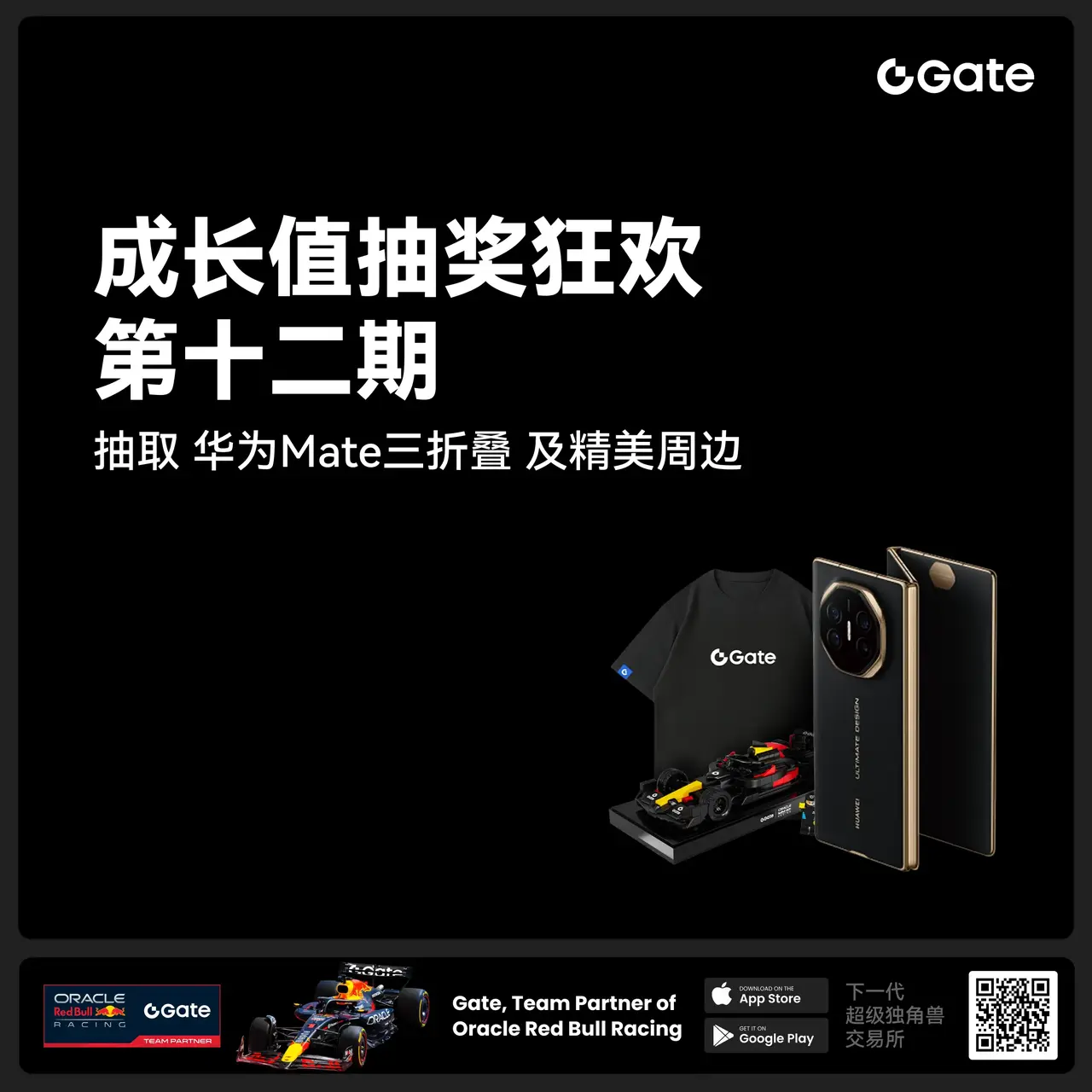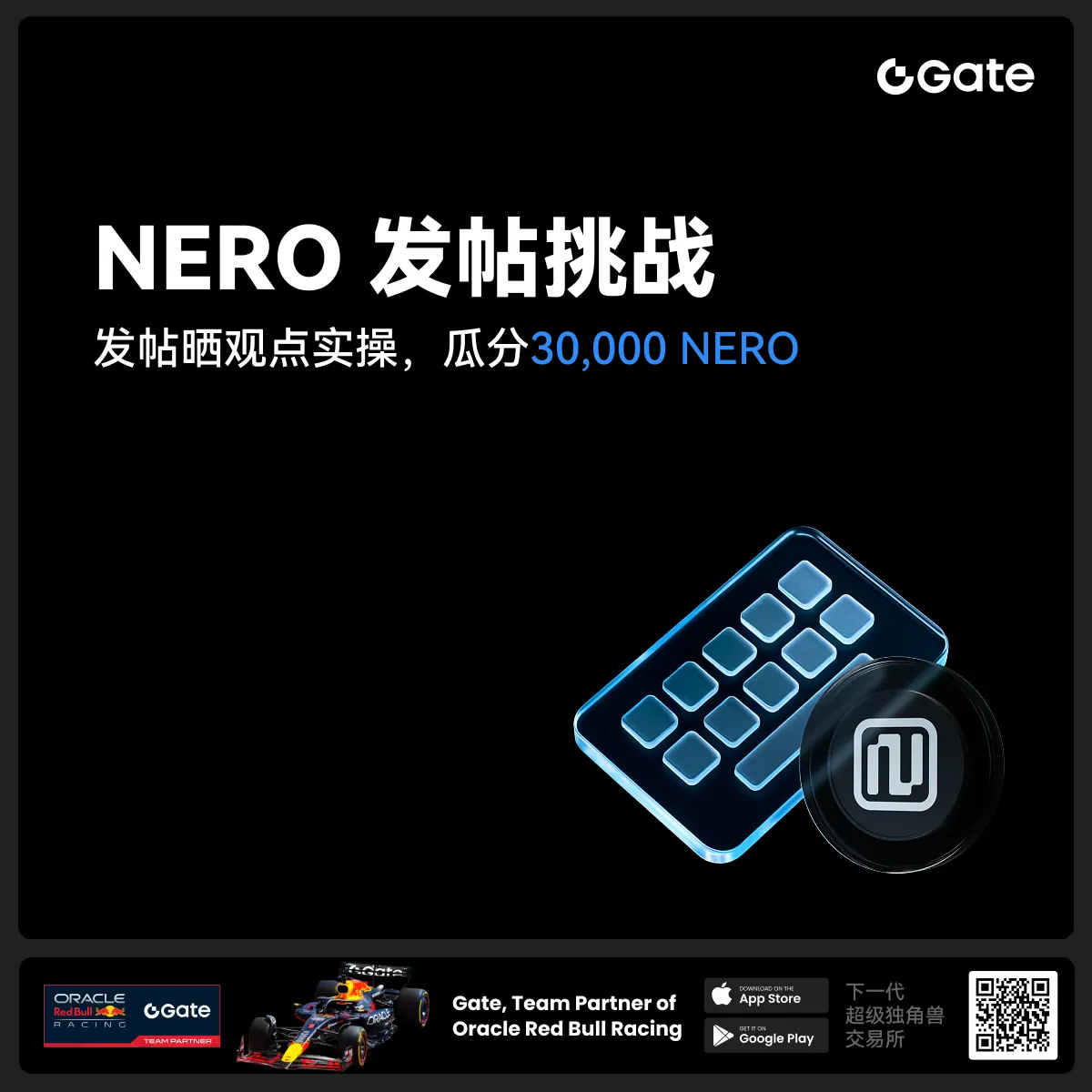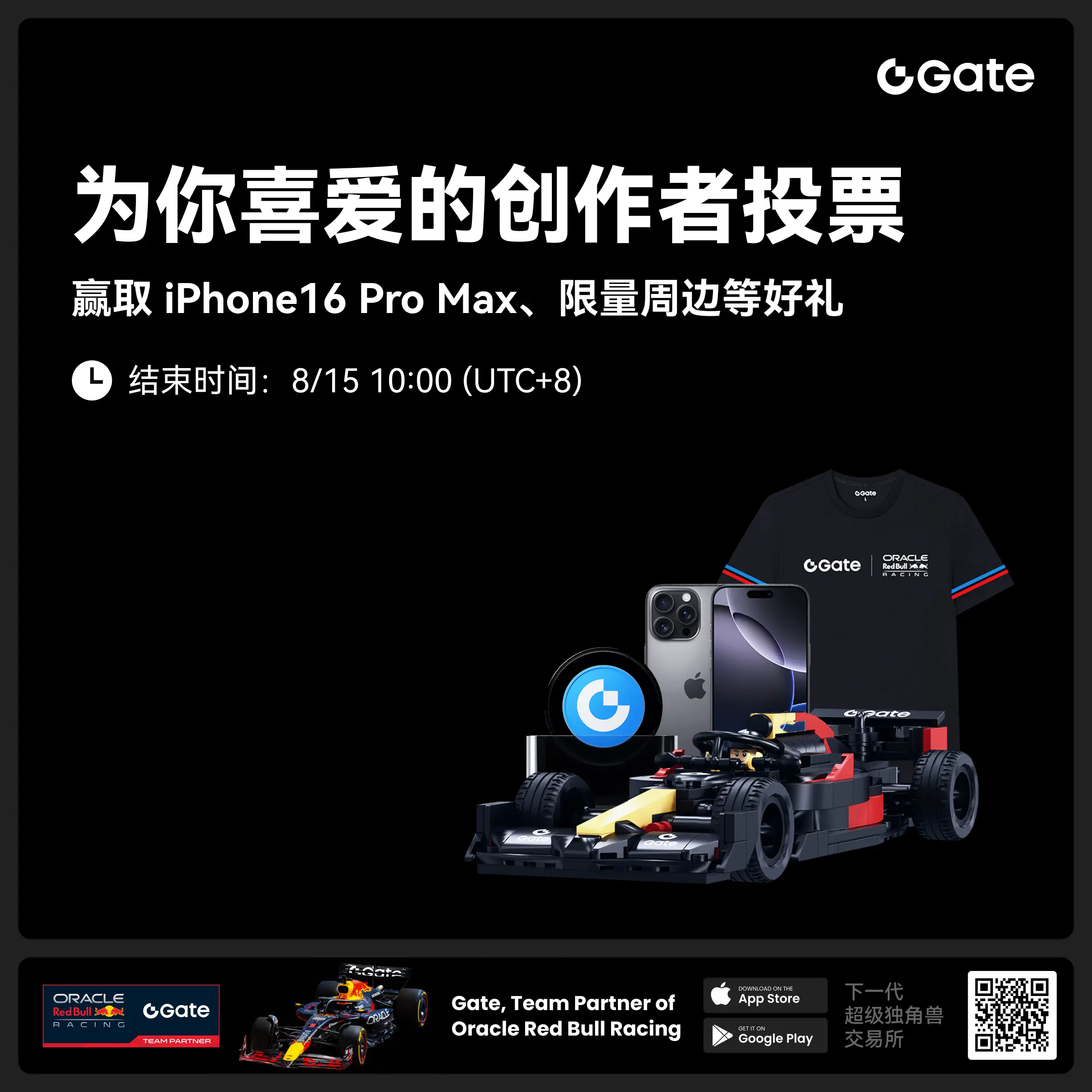- 话题1/3
35k 热度
24k 热度
41k 热度
8k 热度
20k 热度
- 置顶
- 🎉 #CandyDrop合约挑战# 正式开启!参与即可瓜分 6 BTC 豪华奖池!
📢 在 Gate 广场带话题发布你的合约体验
🎁 优质贴文用户瓜分$500 合约体验金券,20位名额等你上榜!
📅 活动时间:2025 年 8 月 1 日 15:00 - 8 月 15 日 19:00 (UTC+8)
👉 活动链接:https://www.gate.com/candy-drop/detail/BTC-98
敢合约,敢盈利
- 🎉 攒成长值,抽华为Mate三折叠!广场第 1️⃣ 2️⃣ 期夏季成长值抽奖大狂欢开启!
总奖池超 $10,000+,华为Mate三折叠手机、F1红牛赛车模型、Gate限量周边、热门代币等你来抽!
立即抽奖 👉 https://www.gate.com/activities/pointprize?now_period=12
如何快速赚成长值?
1️⃣ 进入【广场】,点击头像旁标识进入【社区中心】
2️⃣ 完成发帖、评论、点赞、发言等日常任务,成长值拿不停
100%有奖,抽到赚到,大奖等你抱走,赶紧试试手气!
截止于 8月9日 24:00 (UTC+8)
详情: https://www.gate.com/announcements/article/46384
#成长值抽奖12期开启#
- 📢 Gate广场 #NERO发帖挑战# 秀观点赢大奖活动火热开启!
Gate NERO生态周来袭!发帖秀出NERO项目洞察和活动实用攻略,瓜分30,000NERO!
💰️ 15位优质发帖用户 * 2,000枚NERO每人
如何参与:
1️⃣ 调研NERO项目
对NERO的基本面、社区治理、发展目标、代币经济模型等方面进行研究,分享你对项目的深度研究。
2️⃣ 参与并分享真实体验
参与NERO生态周相关活动,并晒出你的参与截图、收益图或实用教程。可以是收益展示、简明易懂的新手攻略、小窍门,也可以是行情点位分析,内容详实优先。
3️⃣ 鼓励带新互动
如果你的帖子吸引到他人参与活动,或者有好友评论“已参与/已交易”,将大幅提升你的获奖概率!
NERO热门活动(帖文需附以下活动链接):
NERO Chain (NERO) 生态周:Gate 已上线 NERO 现货交易,为回馈平台用户,HODLer Airdrop、Launchpool、CandyDrop、余币宝已上线 NERO,邀您体验。参与攻略见公告:https://www.gate.com/announcements/article/46284
高质量帖子Tips:
教程越详细、图片越直观、互动量越高,获奖几率越大!
市场见解独到、真实参与经历、有带新互动者,评选将优先考虑。
帖子需原创,字数不少于250字,且需获得至少3条有效互动
- 🎉 亲爱的广场小伙伴们,福利不停,精彩不断!目前广场上这些热门发帖赢奖活动火热进行中,发帖越多,奖励越多,快来GET你的专属好礼吧!🚀
1️⃣ #GateLaunchpad上线IKA# |IKA认购体验
在Gate广场带话题晒出你的IKA Launchpad认购体验,4位幸运分享者讲瓜分$200分享奖池!
详情 👉️ https://www.gate.com/post/status/12566958
2️⃣ #ETH冲击4800# |行情分析预测
大胆发帖预测ETH走势,展示你的市场洞察力!10位幸运用户将平分0.1 ETH 奖励!
详情 👉️ https://www.gate.com/post/status/12322403
3️⃣ #创作者活动第二期# |ZKWASM话题
在广场或推特发布与 ZKWASM 或其交易活动相关的原创内容,瓜分4,000枚ZKWASM!
详情 👉️ https://www.gate.com/post/status/12525794
4️⃣ #Gate广场征文活动第二期# |ERA话题
谈谈你对ERA的观点/体验,参与并推广活动,700 ERA大奖等你赢!
详情 👉️ https://www.gate.com/post/status/12361653
5️⃣ #MBG任务挑战# |MBG话题
分享你对MBG的洞察,积极参与和推广MBG活动,20位小 - 🎉Gate 2025 上半年社区盛典:内容达人评选投票火热进行中 🎉
🏆 谁将成为前十位 #Gate广场# 内容达人?
投票现已开启,选出你的心头好
🎁赢取 iPhone 16 Pro Max、限量周边等好礼!
📅投票截止:8 月 15 日 10:00(UTC+8)
立即投票: https://www.gate.com/activities/community-vote
活动详情: https://www.gate.com/announcements/article/45974
The rise of Money2: The next financial system has already begun
Opinion by: Michael Egorov, founder of Curve Finance
The crypto world shifts its focus every few months, with headlines buzzing about AI, integrations, memecoins and grand Web3 visions
While the spotlight moves from trend to trend, a quieter, deeper transformation is taking place beneath the surface: the gradual birth of a new financial system built on stablecoins, decentralized finance (DeFi) and code-driven contracts.
This system can be nominally called “Money2” — and it’s not a theory or a future vision. It’s already here
Reports from early 2025 showed that, in February, the total supply of stablecoins had reached $225 billion in value, achieving 63% year-over-year growth. This surge underscores the expanding role of stablecoins in payments and as a medium of exchange. Consequently, it also positions them as a key element in building a new global financial ecosystem.
Moreover, for the first time in history, financial services can function entirely without intermediaries and trust in third parties. Loans, exchanges and payments no longer need to rely on traditional intermediaries
Instead, they run on smart contracts, transparent and immutable lines of code on decentralized blockchains. Code, not humans, determines how money moves, how it’s lent and how it’s secured This isn’t just a repackaging of existing finance. It’s a break from thousands of years of precedent — a disintermediation that changes everything.
Building a financial system without trust
For all human history, money has depended on trust in people or institutions. Whether transferring money, taking a loan or investing, an intermediary is always involved. Every traditional financial service relies on a bank, a broker or a government-regulated entity — it depends on trusting someone.
Because people and institutions are ultimately fallible, that trust has historically been betrayed many times. Entire legal frameworks, with audits and penalties, have evolved over the years to keep these third parties honest — to better manage that trust
The risk, however, remains.
Money2 eliminates that dependency. In this new paradigm, smart contracts — code on decentralized blockchains — replace intermediaries. Transactions can be executed automatically and transparently without any gatekeepers or bias. Without the need for human discretion or interference. Just code
Related: South Korea’s central bank wants gradual stablecoin rollout
Through DeFi, financial operations can happen without relying on people or institutions because the code is executed exactly as written. There’s no banker to delay, deny a transfer or freeze your funds. Everything is verifiable onchain, and what you see is what you get.
This isn’t just a technical improvement. It’s a leap in the entire philosophy of finance. It means fewer opportunities for corruption, less bureaucracy and the potential to rewire how financial services operate globally, opening the door for more transparent and accessible financial systems.
DeFi and stablecoins matter more than ever
The current crypto narrative has become increasingly distracted and dominated by flashy trends, which distract from the most critical thing blockchain enables: functional, scalable alternatives to traditional finance.
Not all non-financial blockchain use cases are irrelevant
While things like AI integrations into crypto are undoubtedly interesting, they don’t fix the most significant issue: that traditional finance is fundamentally flawed. Money transfers are frequently canceled, international payments are slow, compliance checks can delay onboarding for days — the list goes on
Even basic transactions face failures, delays and significant fees.
DeFi remains the most transformative use case for blockchain technology because it offers a way out from all of that, enabling payments, lending, trading and more without intermediaries. And when combined with stablecoins, these systems form the backbone of Money2
DeFi doesn’t just digitize old frameworks but reimagines them entirely. Even traditional financial institutions themselves can recognize the value of decentralized solutions. It points to a significant shift in how TradFi institutions change their views.
What’s holding DeFi back?
“If Money2 is so revolutionary, why hasn’t it gone mainstream yet?” — is what many might ask at this point. Well, that’s because the shift it demands is uncomfortable in many ways.
And there are still barriers that need to be toppled first.
The first problem is simple: responsibility. Removing intermediaries means users are on their own. Transactions are irreversible, so there is no room for mistakes. Funds are rarely recoverable if you lose access to your wallet or fall for a scam. For many, that’s too much risk to take on
DeFi today requires a steep learning curve, and self-custody is hard. Most people aren’t ready to manage their private keys or navigate the complexity of smart contracts without a safety net. Not when they don’t understand how any of it works or the risks.
Secondly, the web itself isn’t optimized enough for this transformation. Traditional browsers and web architectures currently form the backbone of DeFi interactions, and they weren’t designed to securely handle high-stakes financial transactions. Adoption and usability won’t become widespread until new interfaces are built from the ground up with DeFi specifically in mind.
Finally, there’s also a need to expand what asset classes are actually available in DeFi if it is to be more universally useful
Stablecoins are a good start, but for Money2 to be truly realized as a full-fledged financial system, we need more than just crypto-native elements. Real-world assets, such as stocks, bonds, commodities and real estate, must be tokenized and traded onchain.
Admittedly, that’s a challenge to tackle, whether technically, logistically or legally, so it will take longer to get there. It is also a challenge worth solving. Tokenizing the full array of value-bringing assets will make DeFi a one-stop platform for all financial activities, essential for its continued evolution.
Opinion by: Michael Egorov, founder of Curve Finance.
This article is for general information purposes and is not intended to be and should not be taken as legal or investment advice. The views, thoughts, and opinions expressed here are the author’s alone and do not necessarily reflect or represent the views and opinions of Cointelegraph.